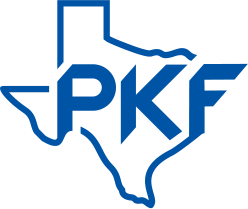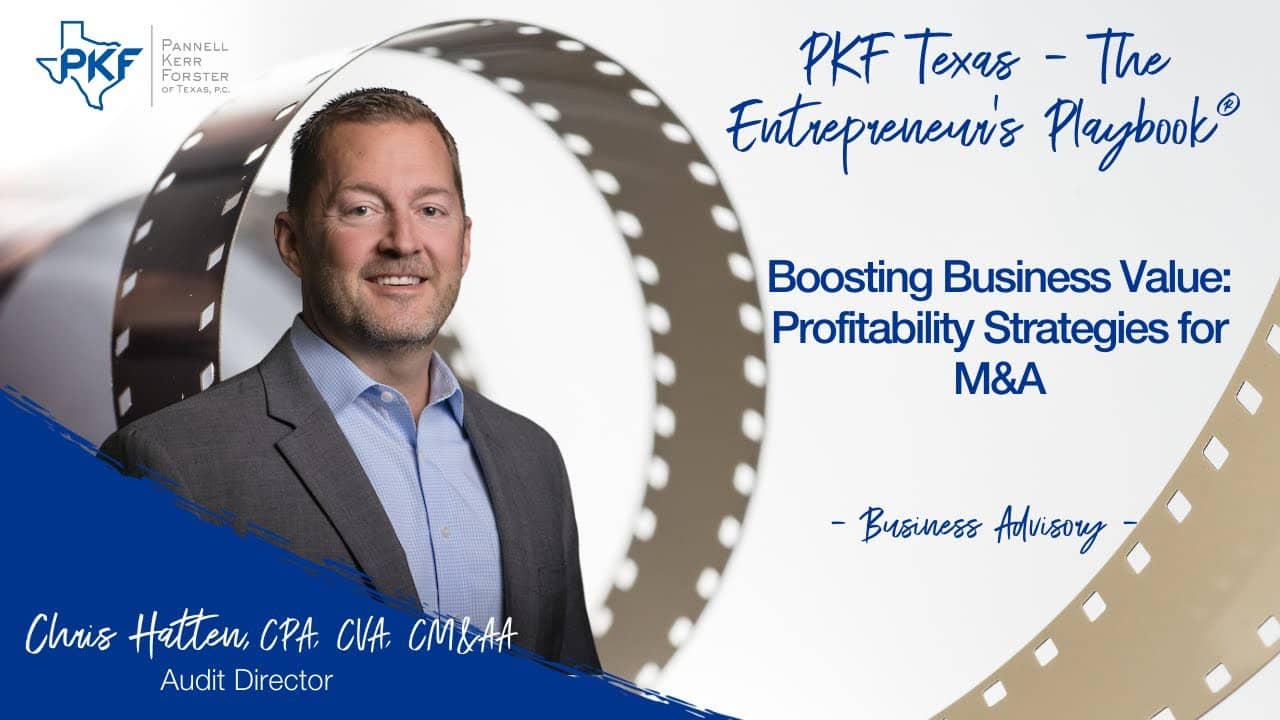Join Jen Lemanski and Chris Hatten, CPA, CM&AA, CVA in this informative episode focused on M&A readiness. Explore the three essential steps every business owner should take when preparing to go to market. From financial reporting to operational optimization and budget implementation, gain valuable insights into making your business attractive to potential buyers. Be well-prepared for the M&A journey with guidance from PKF Texas – the Entrepreneur’s Playbook.
Jen: This is the PKF Texas Entrepreneur’s Playbook, I’m Jen Lemanski, and I’m back here once again with Chris Hatten one of the Approachable Advisors® on our transaction advisory services team. Chris, welcome back to the Playbook.
Chris: Appreciate it, Jen.
Jen: So, I know the M&A markets have slowed a little bit. You know, we’re sitting here at the end of 2023 and looking into 2024. And you know, I think you’ve shared, and some others have shared that some owner operators, they’re potentially looking at exiting in the next year to 18 months. What are some things that they should do to get ready to go to market?
Chris: Yeah, and like I try and do, I try and limit to three different things. And the first one is for the owner operators is ensuring that they have a hard close at the end of each month, and that they’re getting their books closed out. For those owner operators that don’t have a reporting obligation, let’s say, to a bank for financial reporting covenants or something like that, they can afforded to be a little bit loose as far as how they run the business and not have to sit there and operate at like ASEC registrant or something like that because they’re not having to turn their financials over to anybody else other than maybe their other business partners. And so, what we’ve seen is just a lot of times there’s not a hard cutoff is what we call it as far as recording of revenue and all that. And so, what we would ask is that they work on getting that tightened up a little bit.
But then also what we say is we want to kind of clean the noise out of the business. And so, I say accidentally some of these owner operators might run some personal stuff through the business occasionally for whatever tax planning purposes. But as a buyer, you want to understand how the business is operating without that. And some of that would get cleaned up through a buy side or a sell side process. But if a buyer comes up, and this kind of goes back to my other point and says, well, you know, can we see your latest financial statements? And they say, well, I haven’t closed it out and you know, the book’s out in the past three months, so…
Jen: Oh my gosh.
Chris: Yeah. And well, and it happens. And so, they say, well, let me close it out and let me get caught up and we’ll turn those over to you. Well then you hear the stories about private equity having to look at 400 deals just to get four that are serviceable. At that point, they’re like, okay, well they haven’t been serious about running their business. Because they’re not closing things out timely. So, they’ve got 399 more deals in the pipeline that they got to start sifting through. And so, at that point you kind of get moved to the back of the line. This is also an opportunity, I’d say to trim the fat out of the operations of the company. And so, if you can show for an extended period of time, let’s say two to three years, where let’s say you might cut back on advertising a little bit. I know. Not your favorite subject.
Jen: Yeah. Not my favorite subject, but…
Chris: We’ll roll with this one for discussion purposes. But if it’s not affecting your revenue or your bottom line, and you can sit there and say, well we’ve been able to shave a hundred thousand dollars out of that then that’s going to show your company be more profitable and then hopefully it’s going to increase your purchase price. And so, again there’s a bunch of different instances, you could take a look at do we have excess capacity as far as headcount? You know, nobody wants to let anybody go, but, are you carrying too much headcount? Is it time to revisit your suppliers to see if there’s better deals out there? All that, that kind of stuff. And it is stuff that everybody should be doing. But going into the business, you don’t want to sit there and start throwing these levers six months beforehand because then somebody who’s looking at you is going to say, well, we want to see how this is run on the long term.
And then finally I would say implementing a budget. If you don’t have a budget, how do you understand where you’re operating in or whether or not you’re tracking with budget or exceeding budget or versus just having a really good month. So, there’s a bunch of different benefits, but it also helps with the decision making process. And so, if you’re the owner-operator and you’re looking at buying brand new million dollar piece of machinery you’ve got to budget that out because you’ve got to figure out how much is that going to increase your sales how many additional employees do you need to hire, if any, to run that piece of equipment. But then also from a tax planning perspective you’re going to get bonus depreciation and all that kind of stuff potentially from that. So, if I had to limit to those three things, that’s what I would say. I’d say tightening up the financial statement reporting, implementing the budget, but then also cleaning the noise out of the business.
Jen: Perfect. Well, it sounds like we may need to do one on budgeting soon.
Chris: We can do that.
Jen: Awesome. Well, we’ll get you back here to talk about that. Sound good?
Chris: Alright. Thanks Jen.
Jen: This has been another Thought Leader production, brought to you by PKF – Texas the Entrepreneur’s Playbook. For more information about this and other topics, visit pkftexas.com/insights. Tune in next week for another chapter.

